|
The ellesmere canal consists
of a series of navigations proceeding from the river Dee in the vale of
Llangollen. One branch passes northward, near the towns of Ellesmere,
Whitchurch, Nantwich, and the city of Chester, to Ellesmere Port on the
Mersey; another, in a south-easterly direction, through the middle of
Shropshire towards Shrewsbury on the Severn; and a third, in a
south-westerly direction, by the town of Oswestry, to the Montgomeryshire
Canal near Llanymynech; its whole extent, including the Chester Canal,
incorporated with it, being about 112 miles.
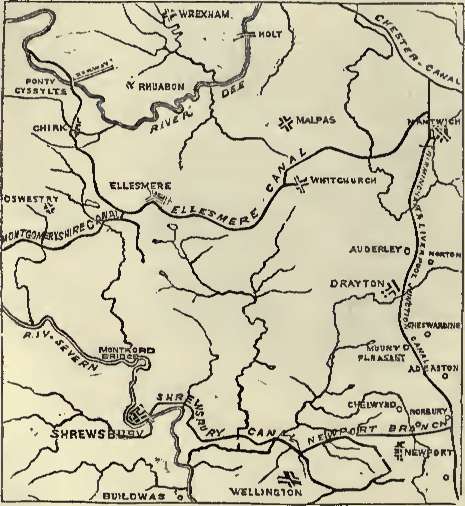
Map of Ellesmere Canal
The success of the Duke of
Bridgewater's Canal had awakened the attention of the landowners throughout
England, but more especially in the districts immediately adjacent to the
scene of the Duke's operations, as they saw with their own eyes the
extraordinary benefits which had followed the opening up of the navigations.
The resistance of the landed gentry, which many of these schemes had
originally to encounter, had now completely given way, and, instead of
opposing canals, they were everywhere found anxious for their construction.
The navigations brought lime, coal, manure, and merchandise, almost to the
farmers' doors, and provided them at the same time with ready means of
conveyance for their produce to good markets. Farms in remote situations
were thus placed more on an equality with those in the neighbourhood of
large towns; rents rose in consequence, and the owners of land everywhere
became the advocates and projectors of canals.
The dividends paid by the
first companies were very high, and it was well known that the Duke's
property was bringing him in immense wealth. There was, therefore, no
difficulty in getting the shares in new projects readily subscribed for:
indeed Mr. Telford relates that at the first meeting of the Ellesmere
projectors, so eager were the public, that four times the estimated expense
was subscribed without hesitation. Yet this navigation passed through a
difficult country, necessarily involving very costly works; and as the
district was but thinly inhabited, it did not present a very inviting
prospect of dividends.*[1] But the mania had fairly set in, and it was
determined that the canal should be made. And whether the investment repaid
the immediate proprietors or not, it unquestionably proved of immense
advantage to the population of the districts through which it passed, and
contributed to enhance the value of most of the adjoining property.
The Act authorising the
construction of the canal was obtained in 1793, and Telford commenced
operations very shortly after his appointment in October of the same year.
His first business was to go carefully over the whole of the proposed line,
and make a careful working survey, settling the levels of the different
lengths, and the position of the locks, embankments, cuttings, and
aqueducts. In all matters of masonry work he felt himself master of the
necessary details; but having had comparatively small experience of
earthwork, and none of canal-making, he determined to take the advice of Mr.
William Jessop on that part of the subject; and he cordially acknowledges
the obligations he was under to that eminent engineer for the kind
assistance which he received from him on many occasions.
The heaviest and most
important part of the undertaking was in carrying the canal through the
rugged country between the rivers Dee and Ceriog, in the vale of Llangollen.
From Nantwich to Whitchurch the distance is 16 miles, and the rise 132 feet,
involving nineteen locks; and from thence to Ellesmere, Chirk, Pont-Cysylltau,
and the river Dee, 1 3/4 mile above Llangollen, the distance is 38 1/4
miles, and the rise 13 feet, involving only two locks. The latter part of
the undertaking presented the greatest difficulties; as, in order to avoid
the expense of constructing numerous locks, which would also involve serious
delay and heavy expense in working the navigation, it became necessary to
contrive means for carrying the canal on the same level from one side of the
respective valleys of the Dee and the Ceriog to the other; and hence the
magnificent aqueducts of Chirk and Pont-Cysylltau, characterised by Phillips
as "among the boldest efforts of human invention in modem times."*[2] The
Chirk Aqueduct carries the canal across the valley of the Ceriog, between
Chirk Castle and the village of that name. At this point the valley is above
700 feet wide; the banks are steep, with a flat alluvial meadow between
them, through which the river flows. The country is finely wooded. Chirk
Castle stands on an eminence on its western side, with the Welsh mountains
and Glen Ceriog as a background; the whole composing a landscape of great
beauty, in the centre of which Telford's aqueduct forms a highly picturesque
object.
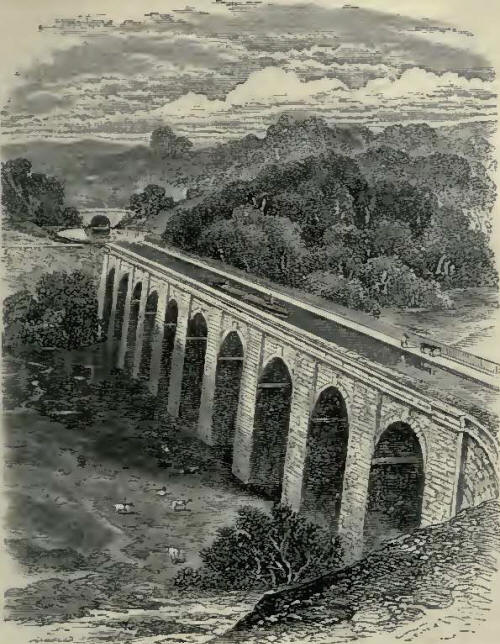
Chirk Aqueduct
The aqueduct consists of ten
arches of 40 feet span each. The level of the water in the canal is 65 feet
above the meadow, and 70 feet above the level of the river Ceriog. The
proportions of this work far exceeded everything of the kind that had up to
that time been attempted in England. It was a very costly structure; but
Telford, like Brindley, thought it better to incur a considerable capital
outlay in maintaining the uniform level of the canal, than to raise and
lower it up and down the sides of the valley by locks at a heavy expense in
works, and a still greater cost in time and water. The aqueduct is a
splendid specimen of the finest class of masonry, and Telford showed himself
a master of his profession by the manner in which he carried out the whole
details of the undertaking. The piers were carried up solid to a certain
height, above which they were built hollow, with cross walls. The spandrels
also, above the springing of the arches, were constructed with longitudinal
walls, and left hollow.*[3] The first stone was laid on the 17th of June,
1796, and the work was completed in the year 1801; the whole remaining in a
perfect state to this day.
The other great aqueduct on
the Ellesmere Canal, named Pont-Cysylltau, is of even greater dimensions,
and a far more striking object in the landscape. Sir Walter Scott spoke of
it to Southey as "the most impressive work of art he had ever seen." It is
situated about four miles to the north of Chirk, at the crossing of the Dee,
in the romantic vale of Llangollen. The north bank of the river is very
abrupt; but on the south side the acclivity is more gradual. The lowest part
of the valley in which the river runs is 127 feet beneath the water-level of
the canal; and it became a question with the engineer whether the valley was
to be crossed, as originally intended, by locking down one side and up the
other--which would have involved seven or eight locks on each side--or by
carrying it directly across by means of an aqueduct.
The execution of the proposed
locks would have been very costly, and the working of them in carrying on
the navigation would necessarily have involved a great waste of water, which
was a serious objection, inasmuch as the supply was estimated to be no more
than sufficient to provide for the unavoidable lockage and leakage of the
summit level. Hence Telford was strongly in favour of an aqueduct; but, as
we have already seen in the case of that at Chirk, the height of the work
was such as to render it impracticable to construct it in the usual manner,
upon masonry piers and arches of sufficient breadth and strength to afford
room for a puddled water-way, which would have been extremely hazardous as
well as expensive. He was therefore under the necessity of contriving some
more safe and economical method of procedure; and he again resorted to the
practice which he had adopted in the construction of the Chirk Aqueduct, but
on a much larger scale.
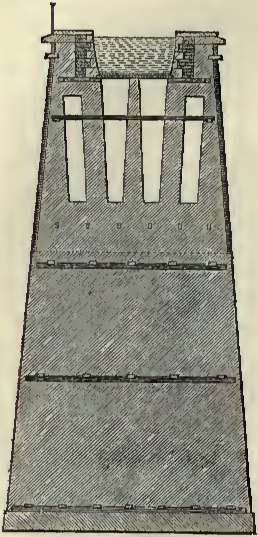
Pont-Cyslltau--Side view of Cast Iron Trough
It will be understood that
many years elapsed between the period at which Telford was appointed
engineer to the Ellesmere Canal and the designing of these gigantic works.
He had in the meantime been carefully gathering experience from a variety of
similar undertakings on which he was employed, and bringing his observations
of the strength of materials and the different forms of construction to bear
upon the plans under his consideration for the great aqueducts of Chirk and
Pont-Cysylltau. In 1795 he was appointed engineer to the Shrewsbury Canal,
which extends from that town to the collieries and ironworks in the
neighbourhood of Wrekin, crossing the rivers Roden and Tern, and Ketley
Brook, after which it joins the Dorrington and Shropshire Canals. Writing to
his Eskdale friend, Telford said: "Although this canal is only eighteen
miles long, yet there are many important works in its course--several locks,
a tunnel about half a mile long, and two aqueducts. For the most
considerable of these last, I have just recommended an aqueduct of iron. It
has been approved, and will be executed under my direction, upon a principle
entirely new, and which I am endeavouring to establish with regard to the
application of iron."*[4]
It was the same principle
which he applied to the great aqueducts of the Ellesmere Canal now under
consideration. He had a model made of part of the proposed aqueduct for
Pont-Cysylltau, showing the piers, ribs, towing-path, and side railing, with
a cast iron trough for the canal. The model being approved, the design was
completed; the ironwork was ordered for the summit, and the masonry of the
piers then proceeded. The foundation-stone was laid on the 25th July, 1795,
by Richard Myddelton, Esq., of Chirk Castle, M.P., and the work was not
finished until the year 1803,--thus occupying a period of nearly eight years
in construction.
The aqueduct is approached on
the south side by an embankment 1500 feet in length, extending from the
level of the water-way in the canal until its perpendicular height at the
"tip" is 97 feet; thence it is carried to the opposite side of the valley,
over the river Dee, upon piers supporting nineteen arches, extending to the
length of 1007 feet. The height of the piers above low water in the river is
121 feet. The lower part of each was built solid for 70 feet, all above
being hollow, for the purpose of saving masonry as well as ensuring good
workmanship. The outer walls of the hollow portion are only two feet thick,
with cross inner walls. As each stone was exposed to inspection, and as both
Telford and his confidential foreman, Matthew Davidson,*[5] kept a vigilant
eye upon the work, scamping was rendered impossible, and a first-rate piece
of masonry was the result.
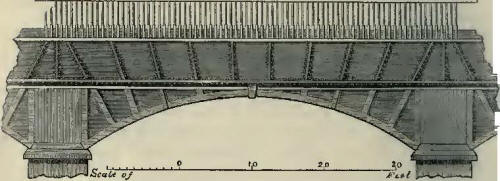
Pont-Cyslltau Aqueduct
Upon the top of the masonry
was set the cast iron trough for the canal, with its towing-path and
side-rails, all accurately fitted and bolted together, forming a completely
water-tight canal, with a water-way of 11 feet 10 inches, of which the
towing-path, standing upon iron pillars rising from the bed of the canal,
occupied 4 feet 8 inches, leaving a space of 7 feet 2 inches for the
boat.*[6] The whole cost of this part of the canal was 47,018L., which was
considered by Telford a moderate sum compared with what it must have cost if
executed after the ordinary manner. The aqueduct was formally opened for
traffic in 1805. "And thus," said Telford, "has been added a striking
feature to the beautiful vale of Llangollen, where formerly was the fastness
of Owen Glendower, but which, now cleared of its entangled woods, contains a
useful line of intercourse between England and Ireland; and the water drawn
from the once sacred Devon furnishes the means of distributing prosperity
over the adjacent land of the Saxons."
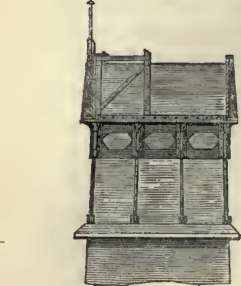
Section of Top of Pont-Cyslltau Aqueduct.
It is scarcely necessary to
refer to the other works upon this canal, some of which were of considerable
magnitude, though they may now seem dwarfed by comparison with the works of
recent engineers, Thus, there were two difficult tunnels cut through hard
rock, under the rugged ground which separates the valleys of the Dee and the
Ceriog. One of these is 500 and the other 200 yards in length. To ensure a
supply of water for the summit of the canal, the lake called Bala Pool was
dammed up by a regulating weir, and by its means the water was drawn off at
Llandisilio when required for the purposes of the navigation; the navigable
feeder being six miles long, carried along the bank of the Llangollen
valley. All these works were skilfully executed; and when the undertaking
was finished, Mr. Telford may be said to have fairly established his
reputation as an engineer of first rate ability.
We now return to Telford's
personal history during this important period of his career. He had long
promised himself a visit to his dear Eskdale, and the many friends he had
left there; but more especially to see his infirm mother, who had descended
far into the vale of years, and longed to see her son once more before she
died. He had taken constant care that she should want for nothing. She
formed the burden of many of his letters to Andrew Little. "Your kindness in
visiting and paying so much attention to her," said he, "is doing me the
greatest favour which you could possibly confer upon me." He sent his friend
frequent sums of money, which he requested him to lay out in providing
sundry little comforts for his mother, who seems to have carried her spirit
of independence so far as to have expressed reluctance to accept money even
from her own son. "I must request," said he, "that you will purchase and
send up what things may be likely to be wanted, either for her or the person
who may be with her, as her habits of economy will prevent her from getting
plenty of everything, especially as she thinks that I have to pay for it,
which really hurts me more than anything else."*[7] Though anxious to pay
his intended visit, he was so occupied with one urgent matter of business
and another that he feared it would be November before he could set out. He
had to prepare a general statement as to the navigation affairs for a
meeting of the committee; he must attend the approaching Salop quarter
sessions, and after that a general meeting of the Canal Company; so that his
visit must be postponed for yet another month. "Indeed," said he, "I am
rather distressed at the thoughts of running down to see a kind parent in
the last stage of decay, on whom I can only bestow an affectionate look, and
then leave her: her mind will not be much consoled by this parting, and the
impression left upon mine will be more lasting; than pleasant."*[8]
He did, however, contrive to
run down to Eskdale in the following November. His mother was alive, but
that was all. After doing what he could for her comfort, and providing that
all her little wants were properly attended to, he hastened back to his
responsible duties in connection with the Ellesmere Canal. When at Langholm,
he called upon his former friends to recount with them the incidents of
their youth. He was declared to be the same "canty" fellow as ever, and,
though he had risen greatly in the world, he was "not a bit set up." He
found one of his old fellow workmen, Frank Beattie, become the principal
innkeeper of the place. "What have you made of your mell and chisels?" asked
Telford. "Oh!" replied Beattie, "they are all dispersed--perhaps lost." "I
have taken better care of mine," said Telford; "I have them all locked up in
a room at Shrewsbury, as well as my old working clothes and leather apron:
you know one can never tell what may happen."
He was surprised, as most
people are who visit the scenes of their youth after a long absence, to see
into what small dimensions Langholm had shrunk. That High Street, which
before had seemed so big, and that frowning gaol and court-house in the
Market Place, were now comparatively paltry to eyes that had been familiar
with Shrewsbury, Portsmouth, and London. But he was charmed, as ever, with
the sight of the heather hills and the narrow winding valley--
"Where deep and low the
hamlets lie
Beneath their little patch of sky,
And little lot of stars."
On his return southward, he
was again delighted by the sight of old Gilnockie Castle and the surrounding
scenery. As he afterwards wrote to his friend Little, "Broomholm was in all
his glory." Probably one of the results of this visit was the revision of
the poem of 'Eskdale,' which he undertook in the course of the following
spring, putting in some fresh touches and adding many new lines, whereby the
effect of the whole was considerably improved. He had the poem printed
privately, merely for distribution amongst friends; being careful," as he
said, that "no copies should be smuggled and sold."
Later in the year we find
him, on his way to London on business, sparing a day or two for the purpose
of visiting the Duke of Buckingham's palace and treasures of art at Stowe;
afterwards writing out an eight-page description of it for the perusal of
his friends at Langholm. At another time, when engaged upon the viaduct at
Pont-Cysylltau, he snatched a few day's leisure to run through North Wales,
of which he afterwards gave a glowing account to his correspondent. He
passed by Cader Idris, Snowdon, and Penmaen Mawr. "Parts of the country we
passed through," he says, "very much resemble the lofty green hills and
woody vales of Eskdale. In other parts the magnificent boldness of the
mountains, the torrents, lakes, and waterfalls, give a special character to
the scenery, unlike everything of the kind I had before seen. The vale of
Llanrwst is peculiarly beautiful and fertile. In this vale is the celebrated
bridge of Inigo Jones; but what is a much more delightful circumstance, the
inhabitants of the vale are the most beautiful race of people I have ever
beheld; and I am much astonished that this never seems to have struck the
Welsh tourists. The vale of Llangollen is very fine, and not the least
interesting object in it, I can assure you, is Davidson's famous aqueduct
[Pont-Cysylltau], which is already reckoned among the wonders of Wales. Your
old acquaintance thinks nothing of having three or four carriages at his
door at a time."*[9] It seems that, besides attending to the construction of
the works, Telford had to organise the conduct of the navigation at those
points at which the canal was open for traffic. By the middle of 1797 he
states that twenty miles were in working condition, along which coal and
lime were conveyed in considerable quantifies, to the profit of the Company
and the benefit of the public; the price of these articles having already in
some places been reduced twenty-five, and in others as much as fifty, per
cent. "The canal affairs," he says in one of his letters, "have required a
good deal of exertion, though we are on the whole doing well. But, besides
carrying on the works, it is now necessary to bestow considerable attention
on the creating and guiding of a trade upon those portions which are
executed. This involves various considerations, and many contending and
sometimes clashing interests. In short, it is the working of a great
machine: in the first place, to draw money out of the pockets of a numerous
proprietary to make an expensive canal, and then to make the money return
into their pockets by the creation of a business upon that canal." But, as
if all this business were not enough, he was occupied at the same time in
writing a book upon the subject of Mills. In the year 1796 he had undertaken
to draw up a paper on this topic for the Board of Agriculture, and by
degrees it had grown into a large quarto volume, illustrated by upwards of
thirty plates. He was also reading extensively in his few leisure moments;
and among the solid works which he perused we find him mentioning
Robertson's 'Disquisitions on Ancient India,' Stewart's 'Philosophy of the
Human Mind,' and Alison's 'Principles of Taste.' As a relief from these
graver studies, he seems, above all things, to have taken peculiar pleasure"
In occasionally throwing off a bit of poetry. Thus, when laid up at an hotel
in Chester by a blow on his leg, which disabled him for some weeks, he
employed part of his time in writing his 'Verses on hearing of the Death of
Robert Burns.' On another occasion, when on his way to London, and detained
for a night at Stratford-on-Avon, he occupied the evening at his inn in
composing some stanzas, entitled 'An Address to the River Avon.' And when on
his way back to Shrewsbury, while resting for the night at Bridgenorth, he
amused himself with revising and copying out the verses for the perusal of
Andrew Little. "There are worse employments," he said, "when one has an hour
to spare from business;" and he asked his friend's opinion of the
composition. It seems to have been no more favourable than the verses
deserved; for, in his next letter, Telford says, "I think your observation
respecting the verses to the Avon are correct. It is but seldom I have time
to versify; but it is to me something like what a fiddle is to others, I
apply to it in order to relieve my mind, after being much fatigued with
close attention to business."
It is very pleasant to see
the engineer relaxing himself in this way, and submitting cheerfully to
unfavourable criticism, which is so trying to even the best of tempers. The
time, however, thus taken from his regular work was not loss, but gain.
Taking the character of his occupation into account, it was probably the
best kind of relaxation he could have indulged in. With his head full of
bridges and viaducts, he thus kept his heart open to the influences of
beauty in life and nature; and, at all events, the writing of verses,
indifferent though they might have been, proved of this value to him--that
it cultivated in him the art of writing better prose.
Footnotes for Chapter VI.
*[1] The Ellesmere Canal now
pays about 4 per cent. dividend.
*[2] 'A General History of
Inland Navigation, Foreign and Domestic,' &c. By J. Phillips. Fourth
edition. London, 1803.
*[3]
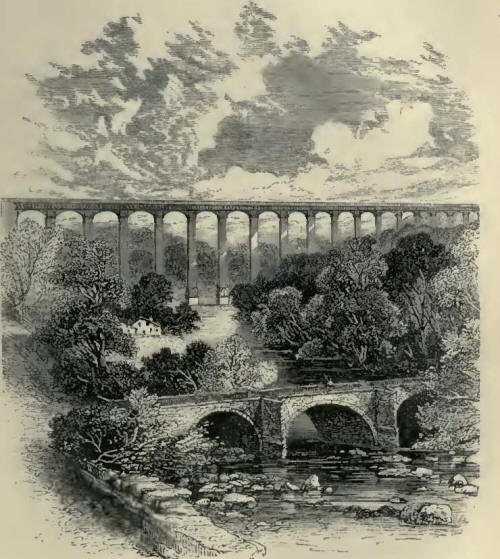
Section of Pier
Telford himself thus modestly
describes the merit of this original contrivance: "Previously to this time
such canal aqueducts had been uniformly made to retain the water necessary
for navigation by means of puddled earth retained by masonry; and in order
to obtain sufficient breadth for this superstructure, the masonry of the
piers, abutments, and arches was of massive strength; and after all this
expense, and every imaginable precaution, the frosts, by swelling the moist
puddle, frequently created fissures, which burst the masonry, and suffered
the water to escape--nay, sometimes actually threw down the aqueducts;
instances of this kind having occurred even in the works of the justly
celebrated Brindley. It was evident that the increased pressure of the
puddled earth was the chief cause of such failures: I therefore had recourse
to the following scheme in order to a void using it. The spandrels of the
stone arches were constructed with longitudinal walls, instead of being
filled in with earth (as at Kirkcudbright Bridge), and across these the
canal bottom was formed by cast iron plates at each side, infixed in square
stone masonry. These bottom plates had flanches on their edges, and were
secured by nuts and screws at every juncture. The sides of the canal were
made water-proof by ashlar masonry, backed with hard burnt bricks laid in
Parker's cement, on the outside of which was rubble stone work, like the
rest of the aqueduct. The towing path had a thin bed of clay under the
gravel, and its outer edge was protected by an iron railing. The width of
the water-way is 11 feet; of the masonry on each side, 5 feet 6 inches; and
the depth of the water in the canal, 5 feet. By this mode of construction
the quantity of masonry is much diminished, and the iron bottom plate forms
a continuous tie, preventing the side-walls from separation by lateral
pressure of the contained water."--'Life of Telford,' p. 40.
*[4] Letter to Mr. Andrew
Little, Langholm, dated Shrewsbury, 13th March, 1795.
*[5] Matthew Davidson had
been Telford's fellow workman at Langholm, and was reckoned an excellent
mason. He died at Inverness, where he had a situation on the Caledonian
Canal.
*[6] Mr. Hughes, C.E., in his
'Memoir of William Jessop,' published in 'Weale's Quarterly Papers on
Engineering,' points out the bold and original idea here adopted, of
constructing a water-tight trough of cast iron, in which the water of the
canal was to be carried over the valleys, instead of an immense puddled
trough, in accordance with the practice until that time in use; and he adds,
"the immense importance of this improvement on the old practice is apt to be
lost sight of at the present day by those who overlook the enormous size and
strength of masonry which would have been required to support a puddled
channel at the height of 120 feet." Mr. Hughes, however, claims for Mr.
Jessop the merit of having suggested the employment of iron, though, in our
opinion, without sufficient reason.
Mr. Jessop was, no doubt,
consulted by Mr. Telford on the subject; but the whole details of the
design, as well as the suggestion of the use of iron (as admitted by Mr.
Hughes himself), and the execution of the entire works, rested with the
acting engineer. This is borne out by the report published by the Company
immediately after the formal opening of the Canal in 1805, in which they
state: "Having now detailed the particulars relative to the Canal, and the
circumstances of the concern, the committee, in concluding their report,
think it but justice due to Mr. Telford to state that the works have been
planned with great skill and science, and executed with much economy and
stability, doing him, as well as those employed by him, infinite credit.
(Signed) Bridgewater."
*[7] Letter to Mr. Andrew
Little, Langholm, dated Shrewsbury, 16th Sept., 1794.
*[8] lbid.
*[9] Letter to Mr. Andrew
Little, Langholm, dated Salop, 20th Aug., 1797. |

